
To mark Indigenous Peoples’ Day, we sit down with the award-winning Indigenous writer, journalist and filmmaker Julian Brave NoiseCat, member of the Canim Lake Band Tsq’escen and a descendant of the Lil’Wat Nation of Mount Currie. His debut book, We Survived the Night, is part-memoir, part-investigative journalism, telling both his family story and the story of Indigenous erasure and resistance in what is now called North America. “I often think about what it must have meant for my ancestors to greet one another in the day by saying something as simple and profound as that they had 'survived the night,'” says NoiseCat. “What did that mean in the winter of 1863, for example, when over two-thirds of our nation died of smallpox? What did it mean in the days after the children were taken away to Indian residential schools?”
Transcript
AMY GOODMAN: This is Democracy Now!, democracynow.org. I’m Amy Goodman.
As over a dozen states and more than 200 cities nationwide commemorate Indigenous Peoples’ Day today, we spend the rest of the hour with award-winning writer, journalist, Oscar-nominated filmmaker Julian Brave NoiseCat.
His debut book, We Survived the Night, out Tuesday, weaves together his family’s stories of survival with personal memories, Indigenous oral histories, legends, on-the-ground reporting, that lay bare the resilience of Indigenous peoples across the continent in the face of centuries of colonial genocide.
We Survived the Night opens with the moment in which Ed Archie NoiseCat, Julian’s father, is found as a newborn baby in a garbage incinerator at the Catholic-run Indian boarding school at St. Joseph’s Mission in British Columbia, in Canada. It was August 16th, 1959.
The story is at the heart of Julian Brave NoiseCat’s Academy Award-nominated documentary Sugarcane, co-directed alongside investigative journalist Emily Kassie. Sugarcane looks at the abuse in cases of missing Indigenous children at St. Joseph, where Julian Brave NoiseCat’s grandmother and other relatives were sent to, near Williams Lake, British Columbia. This year, he made history as the first Indigenous filmmaker from North America to be nominated for an Academy Award in the best documentary feature category. He’s now joining us in our New York City studio.
Thank you so much for being with us, Julian. We’ve talked to you before, but not in the studio. And what an amazing time to do it, with the debut of your book, We Survive the Night. Why the title?
JULIAN BRAVE NOISECAT: Well, I should say Tsecwíncuw-k, Amy, which means not “good morning” in my language, it actually translates to “you survived the night.” And the title of We Survived the Night is actually derived from that traditional morning greeting in Secwepemctsín, my people’s Indigenous language.
You know, I often think about what it must have meant for my ancestors to greet one another in the day by saying something as simple and profound as, you know, that they had “survived the night.” What did that mean in the winter of 1863, for example, when over two-thirds of our nation died of smallpox? What did it mean in the days after the children were taken away to Indian residential schools?
And then I also, you know, chuckle at the way that my own kyé7e, my grandmother, who taught me this language, one of our only two remaining fluent speakers on the Canim Lake Indian Reserve, because of the history of colonization and St. Joseph’s Mission — you know, I think about how she uses it as a kind of a tongue-in-cheek response. You know, I’ll, say, walk into her house, and I’ll say, ”Tsecwíncuw-k, kyé7e,” and she said, “Oh, don’t remind me.” You know?
So, I think that there’s just so much in the poetry of our language, a language that is nearly gone from the face of the Earth, that gets at, you know, not just a social commentary on colonization and survival, but also has a little bit of a dark humor and a wry sensibility to it that I really love.
AMY GOODMAN: So, tell us about your father, Ed Archie NoiseCat, renowned traditional carver, artist, whose work is featured in the Smithsonian, which is now closed because of the government shutdown. But if you can talk about what happened at St. Joseph’s, what happened in Canada? It is one place, but it is emblematic across Canada and across the United States.
JULIAN BRAVE NOISECAT: So, in Canada, for about 150 years, there was a system of church-run, state-funded boarding schools that were segregated, that all Native children in the country were required to attend by an amendment to the Indian Act, which is a federal law, that’s still in place in Canada, that governs who does and does not get to be Native and our lives, in certain ways. And my father’s generation, the generation above my father’s generation were taken away to these schools and separated from their families, forbidden from speaking their languages. And subsequently, there has been a lot of discoveries of abuse, of violence, of rape, of some instances of children dying, who were taken away to these schools.
And it’s important to point out, you know, that the way that this story was often covered in the mainstream media was as a Canadian story, that this was a story specific to the 139 federally funded Indian residential schools in Canada. But, in fact, there were three times as many of these schools — 417 — right here in the United States. So this is truly a story that is foundational to North American history. This is how the land was taken. This is what happened to Native children. And in Canada, the Truth and Reconciliation Commission describes it as a cultural genocide, a system that was designed to wipe the Native way of life off the face of the Earth.
AMY GOODMAN: So, talk about how your father was found.
JULIAN BRAVE NOISECAT: So, in August of 1959, my father was discovered in the trash incinerator at St. Joseph’s Mission by the nightwatchman, a guy named Tony Stoop. He was a Dutchman from the old country. He spoke broken English only. And he pulled up to the school after going to a meeting of the Knights of Columbus, which is a Catholic-adjacent sort of organization in the city of Williams Lake. And when he pulled up to the residential school, he heard what he described in — later to the Williams Lake Tribune as the cry of a cat. It sounded like a cat, is what he said, which is, of course, kind of crazy, because, you know, my last name is NoiseCat. My father’s last name is NoiseCat. And he went with his flashlight to the trash incinerator, and he discovered an ice cream carton, my father, a baby who they described in the papers and in investigations as “Baby X.”
It’s a story that my own family has never really told, and it’s one that I only learned through the making of Sugarcane and the writing of this first book, We Survived the Night.
AMY GOODMAN: And it’s astounding. When you asked your grandmother about why she was there, why the baby, your dad, was found in the garbage, what did she say?
JULIAN BRAVE NOISECAT: She couldn’t answer the question. You know, the truth of the matter is, is that, you know, in the broader history of genocide of Indigenous peoples, there’s one side of the story that I think perhaps your viewers might be a little bit more familiar with, which is the way that governments and churches, you know, purposefully erased or forgot what they did. I think that part of the other side of the equation is what happened to the people who survived these institutions, and the way that we sometimes internalized the violence and the oppression of colonization.
And part of the way that we survived, you know, that incredibly trying experience, over a hundred years of forced assimilation through violence and the separation of children from parents, who were never allowed to raise their own kids, was by forgetting. And that is definitely true for my kyé7e and many others of her generation, who survived by not talking about the incredibly difficult things that they went through, and then sometimes by not talking about the incredibly difficult things that that caused them to do in their own lives.
AMY GOODMAN: What were your thoughts on the pope apologizing? Explain what that was about, and how you have said that, for example, in New Mexico, someone told a person that you spoke to that the Native American population of New Mexico is the most religious, the most observant as Catholics.
JULIAN BRAVE NOISECAT: So, in Sugarcane, we followed the late chief of the Williams Lake First Nation, Rick Gilbert, all the way to the Vatican, where he attended the papal apology to survivors of the Indian residential schools. And I think it’s worth pointing out that that apology was worded not as a collective or institutional apology on behalf of the Catholic Church, but that it was worded in such a way that the Catholic Church was essentially saying there were just a bunch of bad apples all over their barrel, and that, you know, all of these patterns of priests being moved around, of babies being found in incinerators, you know, something that is not necessarily particular to St. Joseph’s Mission and, I think, calls to attention patterns across the Catholic world, in places like Ireland, with the Magdalene laundries, that these are just happenstance coincidence patterns, which I think defies logic. And I think maybe they think that we’re all a little bit stupid. But, you know, essentially, the Catholic Church did a very minimal apology for the actions of very particular priests and staff.
The late Chief Rick Gilbert and many other survivors of those institutions, who remain faithful Catholics, it’s worth pointing out — Rick Gilbert actually had two funerals, and he waited three weeks for his second funeral to be had, so that the bishop in British Columbia could attend. This was a man who was deeply Catholic until the end. You know, he felt very let down by the way that his own church chose to apologize to him and others, children who were taken away to these schools. And I think it’s worth asking, you know: What does the Catholic Church not just owe to people who it wronged, but to people who it wronged who remain faithful Catholics?
AMY GOODMAN: Tell us about your mother, who you dedicate the book to. You write, “For my mother, who showed me how.”
JULIAN BRAVE NOISECAT: Well, you know, the truth of the matter is, is that even though I came out looking the way I look, and I have about as Indian a name as you can possibly imagine — I mean, Julian Brave NoiseCat is a very Native name — my mother is actually an Irish Jewish New Yorker. And when I was about 6 years old, my dad left our family, so I was primarily raised by my non-Native parent.
And the reason the book is dedicated to her is — there are many reasons. I mean, I love my mother very much. But, you know, she made it possible for me to have a relationship to my father’s family on the Canim Lake Indian Reserve, which is an over a 24-hour drive from the city where I grew up, Oakland, California, a whole country away. She beaded my powwow regalia so that I could dance at powwows. She brought me down to the Intertribal Friendship House in Oakland, California, one of the oldest urban Indian community centers in the entire country. And she, to this day, is actually my first reader and editor. So, I love my mom a lot, and I’m really grateful that, you know, she helped keep me connected to my people and my culture.
AMY GOODMAN: And talk about your father, how you kind of rediscovered him well over a decade after he had left you.
JULIAN BRAVE NOISECAT: Yeah, so, my dad, I saw him very sparingly from the age of 6 onwards, you know, maybe about a couple dozen times at most. And then I made a very unusual decision at the age of 28. I was a bachelor living on the East Coast, and I was about to embark on making Sugarcane and writing We Survived the Night, and I decided that I needed to be all in on those stories. And so I decided to move in with my father, who still owed me money that I loaned him to come to my own high school graduation — probably a bit of an unusual decision.
And suddenly we were living across the hallway from one another, cooking each other breakfast. During the day, he’d go out to the carving studio and do his artwork. I would be at my computer working on the documentary and my first book. And I’d also be doing research. You know, I’d be reading these old oral histories that were collected in hundred-plus-year-old ethnographic texts about my Indigenous, you know, traditions, about the trickster Coyote, for example. And then, at night, I’d come back together with my dad, and we’d hang out, eat some dinner. I’d turn on the recorder, and he’d tell me all these stories about his life that I never really knew.
And as I was reflecting on these stories about my father, who was himself an amazing creator and sometimes a destroyer and absolutely a survivor, and reflecting on these stories about the trickster Coyote, who was also an amazing creator and also sometimes a destroyer and also absolutely a survivor, I saw so many parallels between my old man and our, you know, first old man, I guess.
AMY GOODMAN: Julian, you’re wearing a headband, the American flag. Why?
JULIAN BRAVE NOISECAT: To make a little bit of a statement. You know, I think it’s an interesting time to be an Indigenous person in the United States. I also think that there’s a phase in every Native man’s life that they go through wherein they become what I describe as a headband Indian. I know this because I’ve asked many Native men about whether they’ve had a period of life where they wore a headband, and virtually all of them say that they have. And it has to do, I think, if you look at pictures of the American Indian Movement in the 1970s, of things like the occupation of Alcatraz, with a moment in our political reawakening and sense of pride. And, you know, also, I think I wanted to subvert one of the most significant symbols of this land and put it on my head upside down as a way of signifying, you know, my own cultural pride and whose land this really is.
AMY GOODMAN: Julian Brave NoiseCat is a writer, a journalist, an Oscar-nominated filmmaker. His debut memoir is titled We Survived the Night. It’s being released tomorrow, Tuesday, on October 14th. He’s also co-director of the documentary Sugarcane. That does it for our show, but we’re going to do Part 2, and we’re going to put it online at democracynow.org.
I’ll be speaking in Santa Fe, New Mexico, on October 17th at the Lensic Theater, Friday night, after the showing of the film Steal This Story, Please!, along with the Oscar-nominated filmmaker Tia Lessin. So, check our website at democracynow.org. Julian will be speaking at Greenlight Bookstore in Brooklyn. I’m Amy Goodman. Thanks so much for joining us.

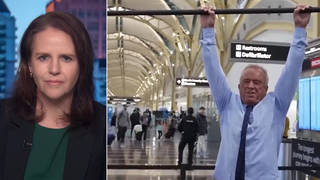
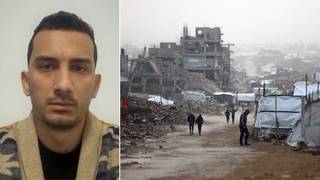
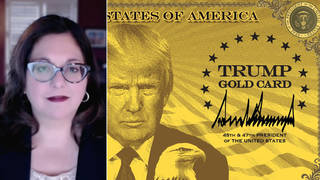
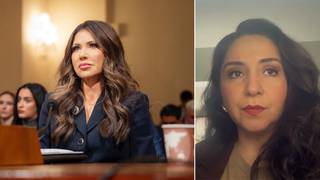
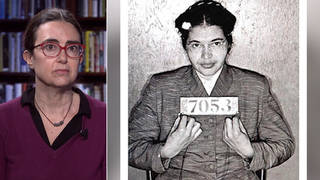
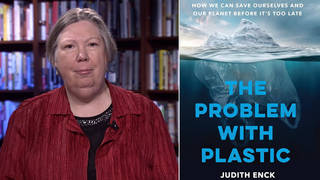
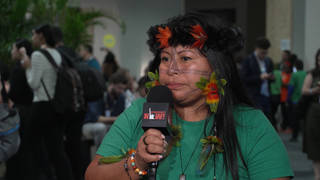
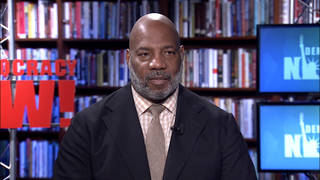
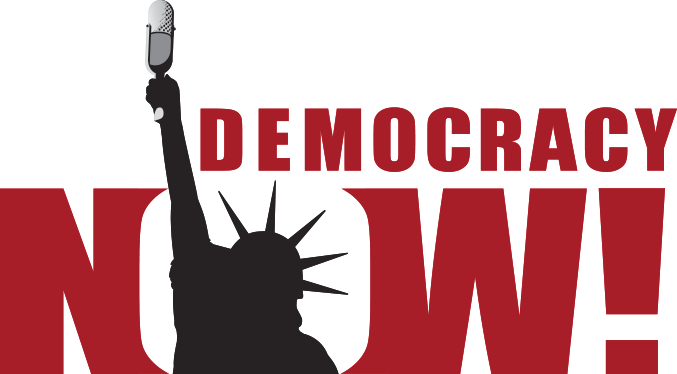
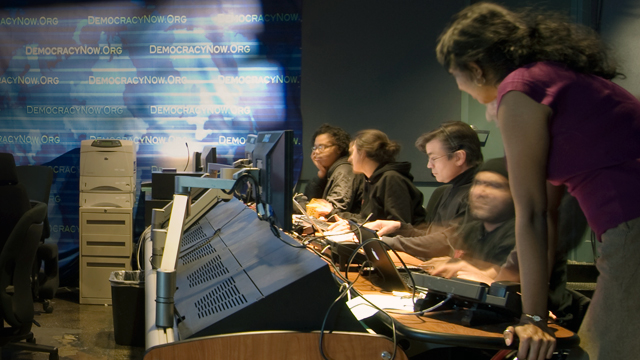

Media Options